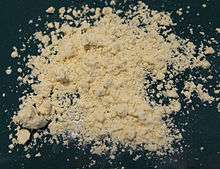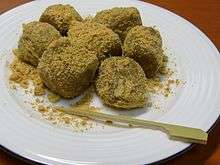Kinako
Kinako (黄粉 or きなこ), also known as roasted soybean flour,[1] is a product commonly used in Japanese cuisine. In English, it is usually called "roasted soy flour". More precisely it is "roasted whole soy flour".[2][3] Usage of the word kinako appeared in cookbooks from the late Muromachi period (1336–1573).[4] Kinako means "yellow flour" in Japanese.

Production
Kinako is produced by finely grinding roasted soybeans into powder.[4][5] The skin of the soybean is typically removed before pulverizing the beans, but some varieties of kinako retain the roasted skin.[5] Yellow soybeans produce a yellow kinako, and green soybeans produce a light-green product.[5] Kinako, being composed of soybeans, is a healthy topping and flavouring which contains B vitamins and protein.[5] Compared to boiled soybeans, however, the protein in kinako is not easily digested.[5]
Usage

Kinako is widely used in Japanese cooking, but is strongly associated with dango and wagashi. Dango, dumplings made from mochiko (rice flour), are commonly coated with kinako.[6] Examples include ohagi and Abekawa-mochi. Kinako, when combined with milk or soy milk, can also be made into a drink. One example of its use in popular foods is warabimochi, which is a famous kinako-covered sweet.
See also
References
- "Kinako" [Progressive Japanese-English Dictionary]. Puroguresshibu Waei Chūjiten [プログレッシブ和英中辞典]. Tokyo: Shogakukan. 2012. Archived from the original on 2007-08-25. Retrieved 2012-06-26.
- Shurtleff, William; Aoyagi, Akiko. 1975. The Book of Tofu: Food for Mankind. Hayama-shi, Kanagawa-ken, Japan: Autumn Press. 336 p. See p. 64–66.
- Shurtleff, W.; Aoyagi, A. 2012. History of Roasted Whole Soy Flour (Kinako), Soy Coffee, and Soy Chocolate (1540–2012). Lafayette, California: Soyinfo Center. 709 pp. (1,420 references; 76 photos and illustrations. Free online)
- "Kinako". Nihon Kokugo Daijiten (日本国語大辞典) (in Japanese). Tokyo: Shogakukan. 2012. Archived from the original on 2007-08-25. Retrieved 2012-05-26.
- "Kinako". Nihon Daihyakka Zensho (Nipponika) (in Japanese). Tokyo: Shogakukan. 2012. Archived from the original on 2007-08-25. Retrieved 2012-05-26.
- Wagashi, traditional Japanese confections, also make extensive use of a mixture of kinako and sugar."Kinako". Dijitaru daijisen (in Japanese). Tokyo: Shogakukan. 2012. Archived from the original on 2007-08-25. Retrieved 2012-05-26.
External links
| Wikimedia Commons has media related to Soy foods. |